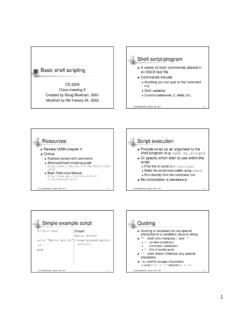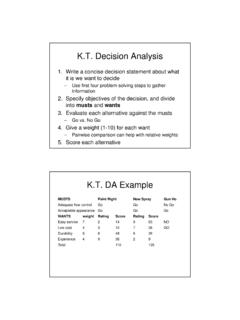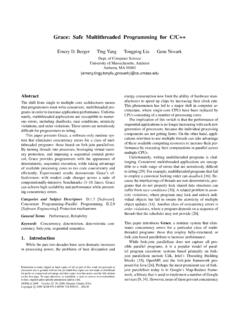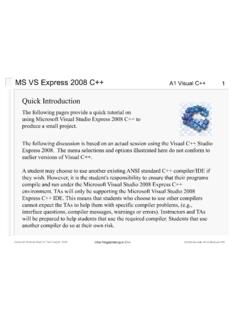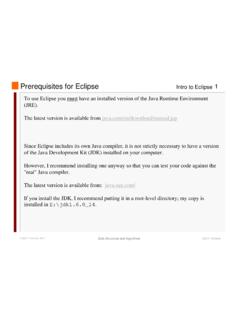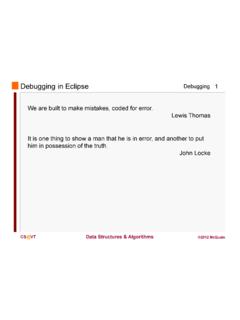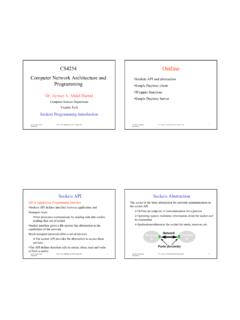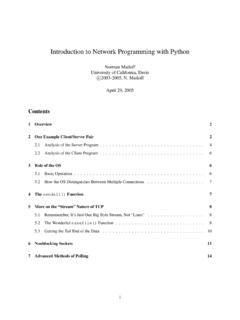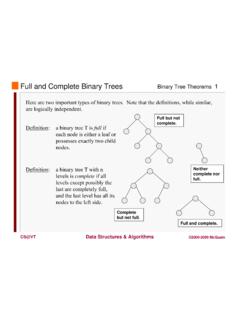Transcription of First Four Steps: Problem Definition
1 KT AnalysisIntro Problem Solving in Computer ScienceCS@VT 2012 McQuain1. Collect and analyze information and data. List every relevent thing you can think of. Fill in missing Talk with people familiar with the Problem . Look past the obvious. Get clarifications when you don t If at all possible, view the Problem First Confirm all Four Steps: Problem DefinitionKT AnalysisIntro Problem Solving in Computer ScienceCS@VT 2012 McQuainUseful for troubleshooting, where cause of Problem is not premise is that there is something that distinguisheswhat the Problem IS from what it IS distinction column is the most Problem AnalysisKT AnalysisIntro Problem Solving in Computer ScienceCS@VT 2012 McQuainISIS NOTD istinctionCauseWhatIdentify:What is Problem ?
2 What is not Problem ?What difference between is and is not?What is possible cause?WhereLocate:Where is Problem found?Where is Problem not found?What difference in locations?What cause?WhenTiming:When does Problem occur?When does Problem not occur?What difference in timing?What cause?When was it First observed?When was it last observed?What difference between 1st, last?What cause?ExtentMagnitude:How far does Problem extend?How localized is Problem ?What is the distinction?What cause?How many units are affected?How many not affected?What is the distinction?What cause?How much of any one unit is affected?
3 How much of any one unit is not affected?What is the distinction?What cause? Problem AnalysisKT AnalysisIntro Problem Solving in Computer ScienceCS@VT 2012 McQuainOn a new model of airplane, flight attendants develop rash on arms, hands, face (only those places). Only occurs on flights over water. Usually disappears after 24 hours. No problems on old planes over those routes. Does not affect all attendants on these flights, but same number of attendants get it on each flight. Those who get rash have no other ill effects. No measurable chemicals, etc., in cabin PA ExampleKT AnalysisIntro Problem Solving in Computer ScienceCS@VT 2012 McQuainISIS NOTDISTINCTIONWHAT:RashOther illnessExternal contactWHEN:New planes usedOld planes usedDifferent materialsWHERE:Flights over waterFlights over landDifferent crew proceduresEXTENT.
4 Face, hands, armsOther partsSomething contacting face, hands and armsOnly some attendantsAll attendantsCrew PA ExampleKT AnalysisIntro Problem Solving in Computer ScienceCS@VT 2012 McQuainGenerating Potential Solutions6 Define the ProblemsGenerate Potential SolutionsDecide a Course of ActionImplement Chosen SolutionEvaluationTo succeed, ultimately you must: define the correct Problem , select the best/acceptable solution for that can t select an acceptable solution unless it gets on the list of potential solutions to be need an effective process for generating potential solution AnalysisIntro Problem Solving in Computer ScienceCS@VT 2012 McQuain1.
5 Defining the Problem too Attacking the symptoms and not the real Assuming there is only one right Getting hooked on an early solution Getting hooked on a solution that almost works (but really doesn t).6. Being distracted by irrelevant information (mental dazzle).7. Getting frustrated by lack of Being too anxious to Defining the Problem Blocks (1)KT AnalysisIntro Problem Solving in Computer ScienceCS@VT 2012 McQuainThere is a direct correlation between the time people spend playing with a Problem and the diversity of the solutions Problem solvers will not cross a perceived imaginary limit some constraint formed in the mind of the solver?
6 ??that does not exist in the Problem Blocks (2)KT AnalysisIntro Problem Solving in Computer ScienceCS@VT 2012 McQuain1. Stereotyping: functional fixedness (einstellung).2. Limiting the Problem Saturation or information Fear of risk Lack of appetite for Judging rather than generating Lack of Inability to of blocks: culture, taboos, environment, inability to express, inflexible/inadequate Problem solving Blocks (3)KT AnalysisIntro Problem Solving in Computer ScienceCS@VT 2012 McQuainBrainstormingFuturingAnalogy and Cross?fertilization10 Generating SolutionsKT AnalysisIntro Problem Solving in Computer ScienceCS@VT 2012 McQuainFree Association lots of flow freely for awhile, then taper to generate more ideas?
7 Vertical ThinkingLateral Thinking11 Generating Solutions: BrainstormingKT AnalysisIntro Problem Solving in Computer ScienceCS@VT 2012 McQuainA more structured approach to generating new ideas as part of brainstorming. Adapt: How can we use this? Modify: What changes can we make? Magnify: Add something? Make stronger, longer, Contract: Split up? Lighten? Rearrange: Interchange, reorganize? Combine: Compromise? Blend?12 Vertical ThinkingKT AnalysisIntro Problem Solving in Computer ScienceCS@VT 2012 McQuainRandom Stimulation Select a word from the dictionary or a list of stimulating People s Views (OPV) Imagine yourself in other ThinkingKT AnalysisIntro Problem Solving in Computer ScienceCS@VT 2012 McQuainAsk leading/stimulating questions, ignore technical feasibility (aka wishful thinking).
8 What are the characteristics of an ideal solution? What currently existing Problem , if solved, would make our lives/jobs easier, or make a difference?14 FuturingKT AnalysisIntro Problem Solving in Computer ScienceCS@VT 2012 McQuainCheese/yogurt factory generates acidic waste byproducts. Traditional approach is to treat the waste so that it can be : Imagine a successful plant with no waste. All such waste has a useful purpose. Protein: Food additives/supplements. Sugar: Ferment for Ethanol. Solid waste: De?icing compound, construction Problem : What to do with waste?
9 15 Futuring ExampleKT AnalysisIntro Problem Solving in Computer ScienceCS@VT 2012 McQuainPainting Let kids paint graffiti on cars. Paint targets and throw balls at them. Paint as something (wagon) for Car Make teeter?totter (upside down). Turn into a go?cart. Let kids drive Use seats as to Use Cars in PlaygroundsKT AnalysisIntro Problem Solving in Computer ScienceCS@VT 2012 McQuain1. State the Generate analogies (the Problem is ).3. Solve the Transfer solution to AnalysisIntro Problem Solving in Computer ScienceCS@VT 2012 McQuainMuch of science is done by combining ideas from different a meeting between pairs such as.
10 Beautician and college professor, police officer and software programmer, automobile mechanic and insurance salesman, banker and gardener, choreographer and air traffic controller, ma tre d and AnalysisIntro Problem Solving in Computer ScienceCS@VT 2012 McQuainDeciding the Course of Action19 Assume we have managed to define a collection of real problems, and we have also generated some potential solutions for each of those , we must decide what course of action to follow:? decide which Problem to address First ? decide which actions to take vs this Problem ? select the best solution from our possible alternatives?

